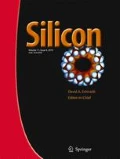Abstract
In this work, we report a 2-D analytical model for threshold voltage and drain current of fully depleted silicon-on-insulator (SoI) metal oxide semiconductor field-effect transistor (MOSFET) with lightly doped N- underneath the N+ source region. This model considers the effect of oxide thickness, source doping variations and silicon film thickness. The accuracy of the proposed model is verified using 2-D numerical simulations in terms of surface potential, threshold voltage and drain current. In comparison with the conventional FD SOI devices, the proposed model predicts that modified source based FD SOI structure gives better OFF-state current, improved ON-state to OFF-state current (ION/IOFF ~ 109) ratio.
Similar content being viewed by others
References
Mishra VK, Chauhan RK (2017) Performance analysis of modified source and TDBC based fully-depleted SOI MOSFET for low power digital applications. Journal of Nanoelectronics and Optoelectronics, American Scientific Publisher 12(1):59–66. https://doi.org/10.1166/jno.2017.2000
Young KK (1989) Short channel effect in fully depleted SOI MOSFETs. IEEE Trans Electron Devices 36:399–401. https://doi.org/10.1109/16.19942
Suzuki K (2003) Short-Channel single-gate SOI MOSFET model. IEEE Trans on Electron Devices 50(5):1297–1305. https://doi.org/10.1109/TED.2003.813450
Banna SR, Chan PCH, Ko PK, Nguyen CT, Chan M (1995) Threshold voltage model for deep-submicron fully depleted SOI MOSFETS. IEEE Trans On Electron Devices 42:1949–1955. https://doi.org/10.1109/16.469402
T. A. Karatsori, A. Tsormpatzoglou, C. G. Theodorou, E. G. Loannidis, S. Haendler, N. Planes, G. Ghibaudo and C. A. Dimitriadis (2015) Development of analytical compact drain current model for 28nm FDSOI MOSFETs, 4thIntern.Conf. on Modern Circuits and Systems Technologies, pp- 1-4. http://mocast.physics.auth.gr/images/NewPapers/PAPER_12F.pdf
Chan M (2003) A framework for generic physics based double-gate MOSFET modeling. NANOTECH 2:270–273 http://www.nsti.org/publications/Nanotech/2003/pdf/W1201.pdf
A. F. Abo-Elhadeed and W. Fikry (2010) Compact model for short and ultra-thin symmetric double gate, 22nd Intern. Conf. on Microelectronics, pp. 24–27, https://doi.org/10.1109/ICM.2010.5696130
Khandelwal S (2012) BSIM-IMG A compact model for ultrathin-body SOI MOSFETs with back-gate control. IEEE Trans On Electron Devices 59(8):2019–2026. https://doi.org/10.1109/TED.2012.2198065
Kumar MJ, Chaudhry A (2004 April) Two dimensional analytical modeling of fully depleted DMG SOI MOSFET and evidence for diminished SCEs. IEEE Trans on Electronic Devices 51(4):569–574. https://doi.org/10.1109/TED.2004.823803
Luo J, Chen J, Wu Q, Chai Z, Yu T, Wang X (2012 May) TDBC SOI technology to suppress floating body effect in PD SOI p-MOSFETs. IET Electronics lett 48(11):652–653. https://doi.org/10.1049/el.2012.0980
L. Jiexin, J. Chen, Q. Wu, Z. Chai, J. Zhou, T. Yu, Y.Dong, L. Li, W. Liu, Q. Chao and X. Wang, “A Tunnel diode body contact structure for high-performance SOI MOSFETs,” IEEE Trans Electron Devices, 59, No. 1, pp. 101-107 2012 Jan., https://doi.org/10.1109/TED.2011.217301
Kumar MJ, Siva M (June 2008) The ground plane in buried oxide for controlling short-channel effects in nanoscale SOI MOSFETs. IEEE Transactions on Electron Devices 55(6):1554–1557. https://doi.org/10.1109/TED.2008.922859
He J, Xi X, Wan H, Dunga M, Chan M, Niknejad AM (2007) BSIM5: An advanced charge-based MOSFET model for nanoscale VLSI circuit simulation. Science Direct, Solid-State Electronics 51:433–444. https://doi.org/10.1016/j.sse.2006.12.006
Kondekar PN, Nigam K, Pandey S, Sharma D (Feb. 2017) Design and analysis of polarity controlled electrically doped tunnel FET with bandgap engineering for analog/RF applications. IEEE Trans Electron Devices 64(2):412–418. https://doi.org/10.1109/TED.2016.2637638
Khatami Y, Banerjee K (Nov. 2009) Steep subthreshold slope n- and p-Type tunnel-FET devices for low-power and energy-efficient digital circuits. IEEE Trans On Electron Devices 56(11):2752–2761. https://doi.org/10.1109/TED.2009.2030831
Choukesy S, Fossum JG, Agrawal S (September 2010) Insights on design and scalability of thin-BOX FD/SOI CMOS. IEEE Trans on Electron Devices 57(9). https://doi.org/10.1109/TED.2010.2052420
Acknowledgements
This work is supported by the AICTE under research program scheme (RPS-60). Authors would like to thank incubation cell of IIT Kanpur for providing Sentaurus tool in VLSI/EDA lab.
Author information
Authors and Affiliations
Corresponding author
Additional information
Publisher’s Note
Springer Nature remains neutral with regard to jurisdictional claims in published maps and institutional affiliations.
Rights and permissions
About this article
Cite this article
Mishra, V.K., Pandey, S., Srivastava, N.A. et al. A Compact Analytical Drain Current Model of Fully Depleted SOI MOSFETs with Lightly Doped N- underneath the N+ Source Region. Silicon 13, 1359–1365 (2021). https://doi.org/10.1007/s12633-020-00525-y
Received:
Accepted:
Published:
Issue Date:
DOI: https://doi.org/10.1007/s12633-020-00525-y



